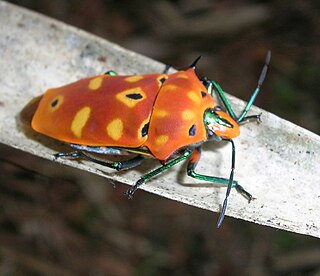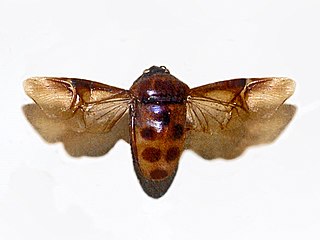
The cicadas are a superfamily, the Cicadoidea, of insects in the order Hemiptera. They are in the suborder Auchenorrhyncha, along with smaller jumping bugs such as leafhoppers and froghoppers. The superfamily is divided into two families, the Tettigarctidae, with two species in Australia, and the Cicadidae, with more than 3,000 species described from around the world; many species remain undescribed.

Hemiptera is an order of insects, commonly called true bugs, comprising over 80,000 species within groups such as the cicadas, aphids, planthoppers, leafhoppers, assassin bugs, bed bugs, and shield bugs. They range in size from 1 mm (0.04 in) to around 15 cm (6 in), and share a common arrangement of piercing-sucking mouthparts. The name "true bugs" is often limited to the suborder Heteroptera.

The Heteroptera are a group of about 40,000 species of insects in the order Hemiptera. They are sometimes called "true bugs", though that name more commonly refers to the Hemiptera as a whole. "Typical bugs" might be used as a more unequivocal alternative, since the heteropterans are most consistently and universally termed "bugs" among the Hemiptera. "Heteroptera" is Greek for "different wings": most species have forewings with both membranous and hardened portions ; members of the primitive sub-group Enicocephalomorpha have completely membranous wings.

The Pentatomoidea are a superfamily of insects in the suborder Heteroptera of the order Hemiptera. As hemipterans, they possess a common arrangement of sucking mouthparts. The roughly 7000 species under Pentatomoidea are divided into 21 families. Among these are the stink bugs and shield bugs, jewel bugs, giant shield bugs, and burrower bugs.

Psyllidae, the jumping plant lice or psyllids, are a family of small plant-feeding insects that tend to be very host-specific, i.e. each plant-louse species only feeds on one plant species (monophagous) or feeds on a few closely related plants (oligophagous). Together with aphids, phylloxerans, scale insects and whiteflies, they form the group called Sternorrhyncha, which is considered to be the most "primitive" group within the true bugs (Hemiptera). They have traditionally been considered a single family, Psyllidae, but recent classifications divide the group into a total of seven families; the present restricted definition still includes more than 70 genera in the Psyllidae. Psyllid fossils have been found from the Early Permian before the flowering plants evolved. The explosive diversification of the flowering plants in the Cretaceous was paralleled by a massive diversification of associated insects, and many of the morphological and metabolic characters that the flowering plants exhibit may have evolved as defenses against herbivorous insects.

The Reduviidae is a large cosmopolitan family of the suborder Heteroptera of the order Hemiptera. Among the Hemiptera and together with the Nabidae almost all species are terrestrial ambush predators; most other predatory Hemiptera are aquatic. The main examples of non-predatory Reduviidae are some blood-sucking ectoparasites in the subfamily Triatominae, with a few species from South America noted for their ability to transmit Chagas disease. Though spectacular exceptions are known, most members of the family are fairly easily recognizable; they have a relatively narrow neck, sturdy build, and a formidable curved proboscis. Large specimens should be handled with caution, if at all, because they sometimes defend themselves with a very painful stab from the proboscis.

Scutelleridae is a family of true bugs. They are commonly known as jewel bugs or metallic shield bugs due to their often brilliant coloration. With the name based on the Asian genus Scutellera, they are also known as shield-backed bugs due to the enlargement of the thoracic scutellum into a continuous shield over the abdomen and wings. This latter characteristic distinguishes them from most other families within Heteroptera, and may lead to misidentification as a beetle rather than a bug. These insects feed on plant juices from a variety of different species, including some commercial crops. Closely related to stink bugs, they may also produce an offensive odour when disturbed. There are around 450 species worldwide.

Nepidae is a family of exclusively aquatic Heteropteran insects in the order Hemiptera. They are commonly called water scorpions for their superficial resemblance to scorpions, due to their raptorial forelegs and the presence of a long slender process at the posterior end of the abdomen, resembling a tail. There are 14 genera in the family, in two subfamilies, Nepinae and Ranatrinae. Members of the genus Ranatra, the most widespread and species-rich genus, are sometimes called needle bugs or water stick insects as they are slenderer than Nepa.

Leafhopper is the common name for any species from the family Cicadellidae. These minute insects, colloquially known as hoppers, are plant feeders that suck plant sap from grass, shrubs, or trees. Their hind legs are modified for jumping, and are covered with hairs that facilitate the spreading of a secretion over their bodies that acts as a water repellent and carrier of pheromones. They undergo a partial metamorphosis, and have various host associations, varying from very generalized to very specific. Some species have a cosmopolitan distribution, or occur throughout the temperate and tropical regions. Some are pests or vectors of plant viruses and phytoplasmas. The family is distributed all over the world, and constitutes the second-largest hemipteran family, with at least 20,000 described species.

Calliphara nobilis is a species of jewel bug found in Asia. Like all species of jewel bugs, it is phytophagous, feeding on the leaves, fruit and seeds of its host plants. This insect is notable for its multiple defense mechanisms: it is highly mobile and swarms disperse with a loud buzz when disturbed; it is aposematically colored, which serves as a warning to any would-be predators that it is unpalatable; and it possesses a robust chemical defense mechanism: it can secrete an irritating and toxic fluid from a pair of metathoracic scent glands when threatened.

Cantao is a genus of true bugs in family Scutelleridae and tribe Scutellerini.

Cantao ocellatus is a species of shield bug in the family Scutelleridae found across Asia. Reddish or ochre in overall colour it has dark legs and bluish black antennae. A dark bluish black stripe is present along the central line of the head. The pronotum sometimes has two black spots on the front margin and sometimes has eight spots. The scutellum has eight or six black spots of variable size but with yellowish borders. The lateral angle of the pronotum is elongated into a curved spine but this can be much reduced. A distinctive symbiotic bacterial genus Sodalis from phylum Gammaproteobacteria is found in its midgut. Maternal care of eggs and nymphs has been noted in this species. The female stands over and covers the eggs after they are laid but eggs on the edge that she cannot cover are often parasitized by wasps.

Sphaerocoris annulus, common names Picasso bug or Zulu hud bug, is a species of shield-backed bugs of the family Scutelleridae.

Calliphara is a genus of insect in the family Scutelleridae (Hemiptera).

Lampromicra senator is an Australian species of insect in the family Scutelleridae, commonly known as the green jewel bug.

Cacama is a genus of cicadas in the family Cicadidae commonly known as cactus dodgers. There are about 12 described species in Cacama.

Camirus is a genus of shield-backed bugs in the family Scutelleridae. There are at least four described species in Camirus.

Calliphara excellens is a jewel bug in the family Scutelleridae. It is distributed in Nepal and India. Males engage in ritualistic Courtship display, walking around the female, touching his abdomen to the plant before touching the female's antennae. After mating, the female oviposits into the seed of a host plant, such as Macaranga tanarius.

Scutellera is the type genus of shield bugs in the subfamily Scutellerinae and tribe Scutellerini. Species are recorded from South and SE Asia.


















